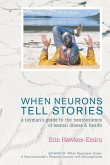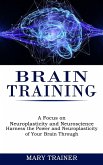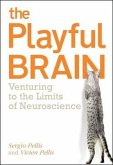22,99 €
inkl. MwSt.
Versandfertig in über 4 Wochen

11 °P sammeln
- Broschiertes Buch
- Merkliste
- Auf die Merkliste
- Bewerten Bewerten
- Teilen
- Produkt teilen
- Produkterinnerung
- Produkterinnerung
A detailed look at the neural and biological mechanisms of psychedelic use
Andere Kunden interessierten sich auch für
![The Benefits of Neuroscience in Education and Health Through the Technique of Cerebral Stimulation Multimedia Rehabilitation - Brain Gymnastics - Neur The Benefits of Neuroscience in Education and Health Through the Technique of Cerebral Stimulation Multimedia Rehabilitation - Brain Gymnastics - Neur]() Luciana Maria Depieri BrancoThe Benefits of Neuroscience in Education and Health Through the Technique of Cerebral Stimulation Multimedia Rehabilitation - Brain Gymnastics - Neur60,99 €
Luciana Maria Depieri BrancoThe Benefits of Neuroscience in Education and Health Through the Technique of Cerebral Stimulation Multimedia Rehabilitation - Brain Gymnastics - Neur60,99 €![The Role of Nutrition During Aging: A Handbook for Nutritional Neuroscience The Role of Nutrition During Aging: A Handbook for Nutritional Neuroscience]() Nafisa M. JadavjiThe Role of Nutrition During Aging: A Handbook for Nutritional Neuroscience43,99 €
Nafisa M. JadavjiThe Role of Nutrition During Aging: A Handbook for Nutritional Neuroscience43,99 €![Psychedelics Psychedelics]() David NuttPsychedelics21,89 €
David NuttPsychedelics21,89 €![When Neurons Tell Stories A Layman's Guide to the Neuroscience of Mental Illness and Health When Neurons Tell Stories A Layman's Guide to the Neuroscience of Mental Illness and Health]() Erin Hawkes-EmiruWhen Neurons Tell Stories A Layman's Guide to the Neuroscience of Mental Illness and Health19,99 €
Erin Hawkes-EmiruWhen Neurons Tell Stories A Layman's Guide to the Neuroscience of Mental Illness and Health19,99 €![Brain Training: A Focus on Neuroplasticity and Neuroscience (Harness the Power and Neuroplasticity of Your Brain Through) Brain Training: A Focus on Neuroplasticity and Neuroscience (Harness the Power and Neuroplasticity of Your Brain Through)]() Mary TrainerBrain Training: A Focus on Neuroplasticity and Neuroscience (Harness the Power and Neuroplasticity of Your Brain Through)18,99 €
Mary TrainerBrain Training: A Focus on Neuroplasticity and Neuroscience (Harness the Power and Neuroplasticity of Your Brain Through)18,99 €![Playful Brain Playful Brain]() Sergio PellisPlayful Brain39,99 €
Sergio PellisPlayful Brain39,99 €![Thieme Test Prep for the Usmle(r) Medical Neuroscience Q&A Thieme Test Prep for the Usmle(r) Medical Neuroscience Q&A]() Manas DasThieme Test Prep for the Usmle(r) Medical Neuroscience Q&A60,99 €
Manas DasThieme Test Prep for the Usmle(r) Medical Neuroscience Q&A60,99 €-
-
-
A detailed look at the neural and biological mechanisms of psychedelic use
Hinweis: Dieser Artikel kann nur an eine deutsche Lieferadresse ausgeliefert werden.
Hinweis: Dieser Artikel kann nur an eine deutsche Lieferadresse ausgeliefert werden.
Produktdetails
- Produktdetails
- Verlag: Inner Traditions/Bear & Company
- 2nd Edition, Revised of Your Brain on Psychedelics edition
- Seitenzahl: 264
- Erscheinungstermin: 8. Oktober 2024
- Englisch
- Abmessung: 227mm x 151mm x 18mm
- Gewicht: 430g
- ISBN-13: 9798888500040
- Artikelnr.: 69929313
- Herstellerkennzeichnung
- Libri GmbH
- Europaallee 1
- 36244 Bad Hersfeld
- gpsr@libri.de
- Verlag: Inner Traditions/Bear & Company
- 2nd Edition, Revised of Your Brain on Psychedelics edition
- Seitenzahl: 264
- Erscheinungstermin: 8. Oktober 2024
- Englisch
- Abmessung: 227mm x 151mm x 18mm
- Gewicht: 430g
- ISBN-13: 9798888500040
- Artikelnr.: 69929313
- Herstellerkennzeichnung
- Libri GmbH
- Europaallee 1
- 36244 Bad Hersfeld
- gpsr@libri.de
Genís Ona, Ph.D., is a psychologist specializing in pharmacology research. An associate professor at the Universitat Rovira i Virgili (URV), he is a member of the Spanish Society of Psychedelic Medicine and of the working group on psychedelics at the Catalan Society of Psychiatry and Mental Health. He has published more than 50 peer-reviewed scientific articles about psychedelic drugs. Currently working as a study coordinator in the psychedelic trials taking place at Sant Joan de Déu Hospital, Barcelona, and in the Medical Anthropology Research Center at URV, he lives in a house in the middle of the wooded Catalan mountains.
Foreword by José Carlos Bouso, Ph.D.
Preface
1 Brief Introduction to Pharmacology
Etymological Origins
Main Pharmacological Concepts
Nervous System • Neurons, Synapses,
and Action Potentials • Pharmacokinetics and
Pharmacodynamics • Neurotransmitters • Receptors •
Modifying Receptor Function
Why Psychedelic Pharmacology?
Pharmacology and Complexity
References for Further Study
2 Pharmacological Classification of the Main
Psychedelic Drugs: Structures and Major Groups
Simple Tryptamines, including Psilocybin
and DMT
Ergolamines, including LSD
Phenethylamines, including Mescaline and MDMA
NMDA Receptor Antagonists, including Ketamine
New Tryptamines
Atypical Psychedelics
Tabernanthe iboga • Salvia divinorum •
Datura stramonium
References for Further Study
3 Biological Targets of Psychedelic Drugs
Simple Tryptamine Targets
Psilocybin • DMT and Ayahuasca
Ergolamine Targets
LSD • LSA
Phenethylamine Targets
Mescaline • MDMA
Targets of NMDA Receptor Antagonists,
including Ketamine
Targets of New Tryptamines
Targets of Atypical Psychedelics
Ibogaine/Noribogaine • Salvinorin-A •
Datura stramonium
References for Further Study
4 Characteristic Aspects of Psychedelic Pharmacology
PHARMACOKINETICS
Initial Phases of the Processing of Psychedelics
Release • Absorption • Distribution
Metabolism
Metabolism and Aging •
Main Centers and Enzymes Responsible for Metabolism
Relevant Aspects in the Metabolism
of Psychedelic Drugs
Psilocybin • DMT/Ayahuasca • LSD • MDMA • Mescaline •
Ketamine • Ibogaine/Noribogaine • Salvinorin-A •
Tropane Alkaloids
Elimination
PHARMACODYNAMICS
Therapeutic Effects of Psychedelics
Antidepressant, Anti-inflammatory, and Neuroprotective
Effects • Therapeutic Effects of Atypical Psychedelics •
Increased Neuroplasticity • Neurological Evidence of
Psychedelics’ Therapeutic Effects • Hormonal Effects •
Psychological Effects
Microdosing Psychedelics as an Emerging Trend
Adverse Effects in the Therapeutic Use of Psychedelics
Toxicity • Studying the Safety of Psychedelics • Health Risks
When Using Psychedelic Drugs Therapeutically
Psychoactive Effects of Psychedelics
Data on Psychedelics' Psychoactive Effects
Tolerance
References for Further Study
5 Harm Reduction in Your Use of Psychedelic Drugs
Take Care of Yourself • Check What You Bought •
Don’t Get Creative with Routes of Administration •
Keep Hydrated • Don’t Mix • Be Patient
6 A Look into the Future: Promises and Challenges
Marketing of Psychedelic Therapies
The Role of Traditional Knowledge
To Trip or Not to Trip
Appendix I: The Legal Status of Psychedelic Drugs
around the World
Appendix II: Glossary
Index
Preface
1 Brief Introduction to Pharmacology
Etymological Origins
Main Pharmacological Concepts
Nervous System • Neurons, Synapses,
and Action Potentials • Pharmacokinetics and
Pharmacodynamics • Neurotransmitters • Receptors •
Modifying Receptor Function
Why Psychedelic Pharmacology?
Pharmacology and Complexity
References for Further Study
2 Pharmacological Classification of the Main
Psychedelic Drugs: Structures and Major Groups
Simple Tryptamines, including Psilocybin
and DMT
Ergolamines, including LSD
Phenethylamines, including Mescaline and MDMA
NMDA Receptor Antagonists, including Ketamine
New Tryptamines
Atypical Psychedelics
Tabernanthe iboga • Salvia divinorum •
Datura stramonium
References for Further Study
3 Biological Targets of Psychedelic Drugs
Simple Tryptamine Targets
Psilocybin • DMT and Ayahuasca
Ergolamine Targets
LSD • LSA
Phenethylamine Targets
Mescaline • MDMA
Targets of NMDA Receptor Antagonists,
including Ketamine
Targets of New Tryptamines
Targets of Atypical Psychedelics
Ibogaine/Noribogaine • Salvinorin-A •
Datura stramonium
References for Further Study
4 Characteristic Aspects of Psychedelic Pharmacology
PHARMACOKINETICS
Initial Phases of the Processing of Psychedelics
Release • Absorption • Distribution
Metabolism
Metabolism and Aging •
Main Centers and Enzymes Responsible for Metabolism
Relevant Aspects in the Metabolism
of Psychedelic Drugs
Psilocybin • DMT/Ayahuasca • LSD • MDMA • Mescaline •
Ketamine • Ibogaine/Noribogaine • Salvinorin-A •
Tropane Alkaloids
Elimination
PHARMACODYNAMICS
Therapeutic Effects of Psychedelics
Antidepressant, Anti-inflammatory, and Neuroprotective
Effects • Therapeutic Effects of Atypical Psychedelics •
Increased Neuroplasticity • Neurological Evidence of
Psychedelics’ Therapeutic Effects • Hormonal Effects •
Psychological Effects
Microdosing Psychedelics as an Emerging Trend
Adverse Effects in the Therapeutic Use of Psychedelics
Toxicity • Studying the Safety of Psychedelics • Health Risks
When Using Psychedelic Drugs Therapeutically
Psychoactive Effects of Psychedelics
Data on Psychedelics' Psychoactive Effects
Tolerance
References for Further Study
5 Harm Reduction in Your Use of Psychedelic Drugs
Take Care of Yourself • Check What You Bought •
Don’t Get Creative with Routes of Administration •
Keep Hydrated • Don’t Mix • Be Patient
6 A Look into the Future: Promises and Challenges
Marketing of Psychedelic Therapies
The Role of Traditional Knowledge
To Trip or Not to Trip
Appendix I: The Legal Status of Psychedelic Drugs
around the World
Appendix II: Glossary
Index
Foreword by José Carlos Bouso, Ph.D.
Preface
1 Brief Introduction to Pharmacology
Etymological Origins
Main Pharmacological Concepts
Nervous System • Neurons, Synapses,
and Action Potentials • Pharmacokinetics and
Pharmacodynamics • Neurotransmitters • Receptors •
Modifying Receptor Function
Why Psychedelic Pharmacology?
Pharmacology and Complexity
References for Further Study
2 Pharmacological Classification of the Main
Psychedelic Drugs: Structures and Major Groups
Simple Tryptamines, including Psilocybin
and DMT
Ergolamines, including LSD
Phenethylamines, including Mescaline and MDMA
NMDA Receptor Antagonists, including Ketamine
New Tryptamines
Atypical Psychedelics
Tabernanthe iboga • Salvia divinorum •
Datura stramonium
References for Further Study
3 Biological Targets of Psychedelic Drugs
Simple Tryptamine Targets
Psilocybin • DMT and Ayahuasca
Ergolamine Targets
LSD • LSA
Phenethylamine Targets
Mescaline • MDMA
Targets of NMDA Receptor Antagonists,
including Ketamine
Targets of New Tryptamines
Targets of Atypical Psychedelics
Ibogaine/Noribogaine • Salvinorin-A •
Datura stramonium
References for Further Study
4 Characteristic Aspects of Psychedelic Pharmacology
PHARMACOKINETICS
Initial Phases of the Processing of Psychedelics
Release • Absorption • Distribution
Metabolism
Metabolism and Aging •
Main Centers and Enzymes Responsible for Metabolism
Relevant Aspects in the Metabolism
of Psychedelic Drugs
Psilocybin • DMT/Ayahuasca • LSD • MDMA • Mescaline •
Ketamine • Ibogaine/Noribogaine • Salvinorin-A •
Tropane Alkaloids
Elimination
PHARMACODYNAMICS
Therapeutic Effects of Psychedelics
Antidepressant, Anti-inflammatory, and Neuroprotective
Effects • Therapeutic Effects of Atypical Psychedelics •
Increased Neuroplasticity • Neurological Evidence of
Psychedelics’ Therapeutic Effects • Hormonal Effects •
Psychological Effects
Microdosing Psychedelics as an Emerging Trend
Adverse Effects in the Therapeutic Use of Psychedelics
Toxicity • Studying the Safety of Psychedelics • Health Risks
When Using Psychedelic Drugs Therapeutically
Psychoactive Effects of Psychedelics
Data on Psychedelics' Psychoactive Effects
Tolerance
References for Further Study
5 Harm Reduction in Your Use of Psychedelic Drugs
Take Care of Yourself • Check What You Bought •
Don’t Get Creative with Routes of Administration •
Keep Hydrated • Don’t Mix • Be Patient
6 A Look into the Future: Promises and Challenges
Marketing of Psychedelic Therapies
The Role of Traditional Knowledge
To Trip or Not to Trip
Appendix I: The Legal Status of Psychedelic Drugs
around the World
Appendix II: Glossary
Index
Preface
1 Brief Introduction to Pharmacology
Etymological Origins
Main Pharmacological Concepts
Nervous System • Neurons, Synapses,
and Action Potentials • Pharmacokinetics and
Pharmacodynamics • Neurotransmitters • Receptors •
Modifying Receptor Function
Why Psychedelic Pharmacology?
Pharmacology and Complexity
References for Further Study
2 Pharmacological Classification of the Main
Psychedelic Drugs: Structures and Major Groups
Simple Tryptamines, including Psilocybin
and DMT
Ergolamines, including LSD
Phenethylamines, including Mescaline and MDMA
NMDA Receptor Antagonists, including Ketamine
New Tryptamines
Atypical Psychedelics
Tabernanthe iboga • Salvia divinorum •
Datura stramonium
References for Further Study
3 Biological Targets of Psychedelic Drugs
Simple Tryptamine Targets
Psilocybin • DMT and Ayahuasca
Ergolamine Targets
LSD • LSA
Phenethylamine Targets
Mescaline • MDMA
Targets of NMDA Receptor Antagonists,
including Ketamine
Targets of New Tryptamines
Targets of Atypical Psychedelics
Ibogaine/Noribogaine • Salvinorin-A •
Datura stramonium
References for Further Study
4 Characteristic Aspects of Psychedelic Pharmacology
PHARMACOKINETICS
Initial Phases of the Processing of Psychedelics
Release • Absorption • Distribution
Metabolism
Metabolism and Aging •
Main Centers and Enzymes Responsible for Metabolism
Relevant Aspects in the Metabolism
of Psychedelic Drugs
Psilocybin • DMT/Ayahuasca • LSD • MDMA • Mescaline •
Ketamine • Ibogaine/Noribogaine • Salvinorin-A •
Tropane Alkaloids
Elimination
PHARMACODYNAMICS
Therapeutic Effects of Psychedelics
Antidepressant, Anti-inflammatory, and Neuroprotective
Effects • Therapeutic Effects of Atypical Psychedelics •
Increased Neuroplasticity • Neurological Evidence of
Psychedelics’ Therapeutic Effects • Hormonal Effects •
Psychological Effects
Microdosing Psychedelics as an Emerging Trend
Adverse Effects in the Therapeutic Use of Psychedelics
Toxicity • Studying the Safety of Psychedelics • Health Risks
When Using Psychedelic Drugs Therapeutically
Psychoactive Effects of Psychedelics
Data on Psychedelics' Psychoactive Effects
Tolerance
References for Further Study
5 Harm Reduction in Your Use of Psychedelic Drugs
Take Care of Yourself • Check What You Bought •
Don’t Get Creative with Routes of Administration •
Keep Hydrated • Don’t Mix • Be Patient
6 A Look into the Future: Promises and Challenges
Marketing of Psychedelic Therapies
The Role of Traditional Knowledge
To Trip or Not to Trip
Appendix I: The Legal Status of Psychedelic Drugs
around the World
Appendix II: Glossary
Index







